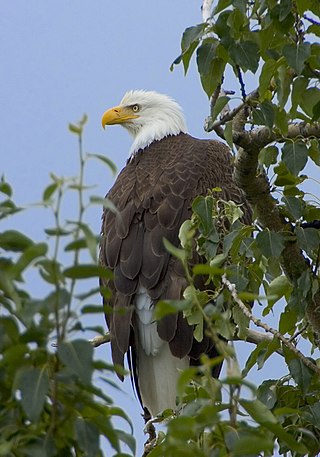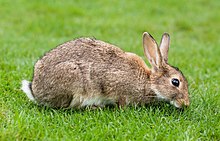
India is the world's 8th most biodiverse region with a 0.46 BioD score on diversity index, 102,718 species of fauna and 23.39% of the nation's geographical area under forest and tree cover in 2020. India encompasses a wide range of biomes: desert, high mountains, highlands, tropical and temperate forests, swamplands, plains, grasslands, areas surrounding rivers, as well as island archipelago. Officially, four out of the 36 Biodiversity Hotspots in the world are present in India: the Himalayas, the Western Ghats, the Indo-Burma and the Nicobar Islands. To these may be added the Sundarbans and the Terrai-Duar Savannah grasslands for their unique foliage and animal species. These hotspots have numerous endemic species. Nearly 5% of India's total area is formally classified under protected areas.
The fauna of Maine include several diverse land and aquatic animal species, especially those common to the North Atlantic Ocean and deciduous forests of North America. Some of these creatures' habitats has been reduced or fully removed.

The fauna of Canada consist of approximately 200 mammal species, over 460 native bird species, 43 amphibian species, 43 reptile species, and 1,200 fish species. The biology survey of Canada cites that there are approximately 55,000 species of insects, and 11,000 species of mites and spiders.

The fauna of the United States of America is all the animals living in the Continental United States and its surrounding seas and islands, the Hawaiian Archipelago, Alaska in the Arctic, and several island-territories in the Pacific and in the Caribbean. The U.S. has many endemic species found nowhere else on Earth. With most of the North American continent, the U.S. lies in the Nearctic, Neotropic, and Oceanic faunistic realms, and shares a great deal of its flora and fauna with the rest of the American supercontinent.

The island of Great Britain, along with the rest of the archipelago known as the British Isles, has a largely temperate climate. It contains a relatively small fraction of the world's wildlife. The biota was severely diminished in the last ice age, and shortly thereafter was separated from the continent by the English Channel's formation. Since then, humans have hunted the most dangerous forms to extinction, though domesticated forms such as the dog and the pig remain. The wild boar has subsequently been reintroduced as a meat animal.

The wildlife of Armenia includes the wild boar, crested porcupine, various lizards, snakes and numerous species of birds and plants. Endangered species in Armenia are the bear, wild goat, Armenian mouflon and the leopard.
The wildlife of Japan includes its flora, fauna, and natural habitats. The islands of Japan stretch a long distance from north to south and cover a wide range of climatic zones. This results in a high diversity of wildlife despite Japan's isolation from the mainland of Asia. In the north of the country, north of Blakiston's Line, there are many subarctic species which have colonized Japan from the north. In the south there are south-east Asian species, typical of tropical regions. Between these areas lies the temperate zone which shares many species with China and Korea. Japan also has many endemic species that are found nowhere else in the world, making it home to many endangered/rare species.

The wildlife of Jordan includes its flora and fauna and their natural habitats. Although much of the country is desert, it has several geographic regions, each with a diversity of plants and animals adapted to their own particular habitats. Fossil finds show that in Palaeolithic times, the region had Syrian brown bears, Asiatic lions and Syrian elephants, but these species are all now extinct in this region.

The wildlife of Algeria is composed of its flora and fauna. Mountains, chotts, wetlands, and grassy desert-like regions all support a wide range of wildlife. The most commonly seen animals include the wild boars, jackals, and gazelles, although it is not uncommon to spot fennecs and jerboas. Leopards and cheetahs are seldom seen.

The fauna of Europe is all the animals living in Europe and its surrounding seas and islands. Europe is the western part of the Palearctic realm. Lying within the temperate region, the wildlife is not as rich as in the hottest regions, but is nevertheless diverse due to the variety of habitats and the faunal richness of Eurasia as a whole.

The animals living in Asia and its surrounding seas and islands are considered the fauna of Asia. Since there is no natural biogeographic boundary in the west between Europe and Asia, the term "fauna of Asia" is somewhat elusive but it is a geographical name given. Temperate Asia is the eastern part of the Palearctic realm, and its south-eastern part belongs to the Indomalayan realm. Asia shows a notable diversity of habitats, with significant variations in rainfall, altitude, topography, temperature and geological history, which is reflected in its richness and diversity of animal life.

The fauna of Toronto include a variety of different species situated within the city limits. Toronto contains a mosaic of ecosystems that includes forests, rivers, streams, and wetlands, which allows it to support a large variety of fauna. Approximately 87 to 90 per cent of the city's indigenous flora and fauna inhabit the city reside within the Toronto ravine system. The city's ravine system, creeks and rivers are wildlife corridors that allow animals to travel from one area of the city to another. Although most animals in Toronto reside within the ravine system, several animals also live in the city's urban environment and parks.

Fauna of Wales includes marine and land animals, birds and reptiles that are resident, visitors or have been introduced to Wales.

The fauna of Italy comprises all the animal species inhabiting the territory of the Italian Republic and its surrounding waters. Italy has the highest level of faunal biodiversity in Europe, with over 57,000 species recorded, representing more than a third of all European fauna. This is due to various factors. The Italian peninsula is in the centre of the Mediterranean Sea, forming a corridor between central Europe and North Africa, and it has 8,000 km (5,000 mi) of coastline. Italy also receives species from the Balkans, Eurasia, and the Middle East. Italy's varied geological structure, including the Alps and the Apennines, Central Italian woodlands, and Southern Italian Garigue and Maquis shrubland, also contribute to high climate and habitat diversity.

The biodiversity of Wales is the wide variety of ecosystems, living organisms, and the genetic makeups found in Wales.

The fauna of the U.S. state of California may be the most diverse in the United States. Of the lower 48 contiguous states, California has the greatest diversity in climate, terrain, and geology. The state's six life zones are the lower Sonoran (desert); upper Sonoran ; transition ; and the Canadian, Hudsonian, and Arctic zones, comprising California's highest elevations. California's diverse geography gives rise to dozens of ecosystems, each of which has its own native plants and animals. California is a huge state, the third largest in the U.S., and ranges broadly in habitats.

The fauna of Louisiana is characterized by the region's low swamplands, bayous, creeks, woodlands, coastal marshlands and beaches, and barrier islands covering an estimated 20,000 square miles, corresponding to 40 percent of Louisiana's total land area. Southern Louisiana contains up to fifty percent of the wetlands found in the Continental United States, made up of countless bayous and creeks.

Montenegro is the smallest Balkan nation in population and second smallest in land mass. The land mass is 13,812 square kilometres with 360 square kilometres of water. Montenegro's geography ranges from mountainous forested regions in the north where larger mammals are most common. Mediterranean coastline makes up the south end of the country, forested area makes up 40.4% of the nation's landmass. The most densely populated area of the country is the south coast and the most sparsely populated is the north east section of the country. The fauna of Montenegro is predominantly shared with surrounding Balkan nations.

The wildlife of Norway includes the diverse flora and fauna of Norway. The habitats include high mountains, tundras, rivers, lakes, wetlands, sea coast and some lower cultivated land in the south. Mainland Norway has a long coastline, protected by skerries and much dissected by fjords, and the mostly-icebound archipelago of Svalbard lies further north. The flora is very varied and a large range of mammals, birds, fish and invertebrate species live here, as well as a few species of reptiles and amphibians.

The wildlife of Spain includes the diverse flora and fauna of Spain. The country located at the south of France has two long coastlines, one on the north on the Cantabrian Sea, another on the East and South East on the Mediterranean Sea, and a smaller one on the west and south west on the Atlantic Ocean, its territory includes a big part of the Iberian Peninsula, the Canary Islands, the Balearic Islands and two enclaves in North Africa, Ceuta and Melilla. and the different climate zones, Spain is one of the countries in Europe with the greatest biodiversity.

























